The future of the video game industry looks dazzling. Consumer demand is growing, technology is advancing quickly, and new monetization models are taking off. Bain’s analysis forecasts that global revenue for games could grow by more than 50% over the next five years (see Figure 1). And gamers’ foothold in virtual worlds—collectively called the metaverse—is far ahead of other consumers.
All this suggests that gaming will take consumers’ time from other forms of media and be the foundational platform for both other media and nonmedia experiences, becoming an ever greater part of our daily lives.
Global video gaming revenue could grow by more than 50% over the next five years
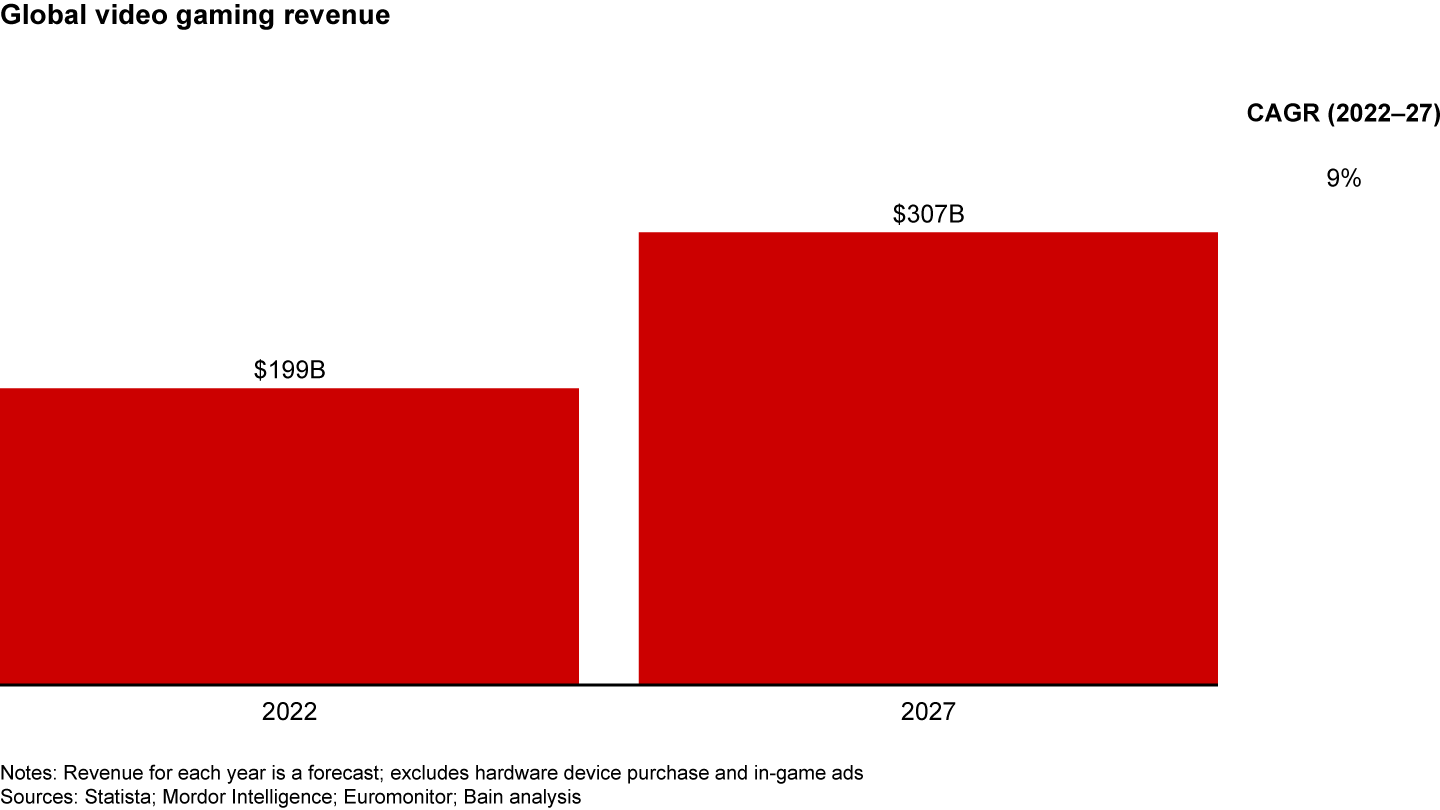
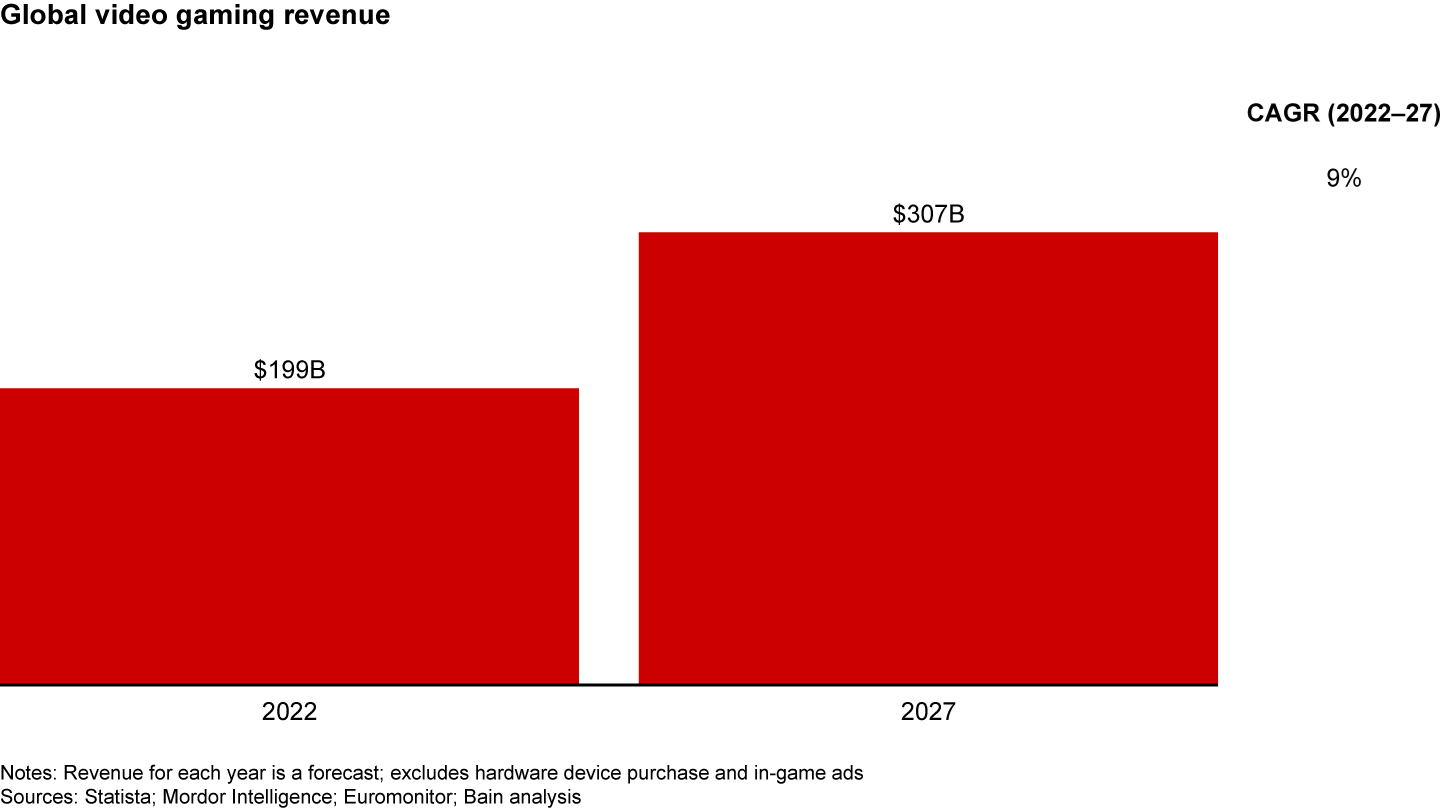
This won’t be a winner-takes-all model. There’s room for success across the spectrum, from high-resolution immersive games (such as Red Dead Redemption 2 and Horizon Forbidden West) to low-cost, indie, and pixel-art games (like Stardew Valley and Among Us). The ubiquity of mobile phones means that even free-to-play casual games will draw huge numbers and add significant revenue to the markets.
However, large, virtual world games, played by fewer but more engaged gamers over multiple platforms, are likely to contribute more to the industry’s profits, given the monetization opportunities through microtransactions within games, and through other media experiences, virtual events, and commerce.
How should game developers and publishers prepare to make the most of this opportunity? Since 2019, over $240 billion in investment has poured into the industry from venture capital, private equity, merger-and-acquisition (M&A) plays by technology and media giants, and robust investment by traditional gaming companies. Just as we’ve seen with video streaming companies over the past few years, where outsized investment generated a wave of content, this is the moment for game companies to bet big and move to the next level.
The gaming industry’s growth is being accelerated by heavy engagement of younger gamers (ages 13 to 17) who spend about 40% more time in video game environments than with any other form of media, including social, music, and TV (see Figure 2). Compared with slightly older gamers (18 to 34 years), younger gamers expect to spend more time in virtual worlds, more time with augmented and virtual reality games, and more time watching e-sports. They’re more comfortable in virtual environments, and just over half of them prefer hanging out with friends in a game rather than in person.
Games are the top media choice for younger gamers, while older gamers spend about as much time on social media and music as they do on games
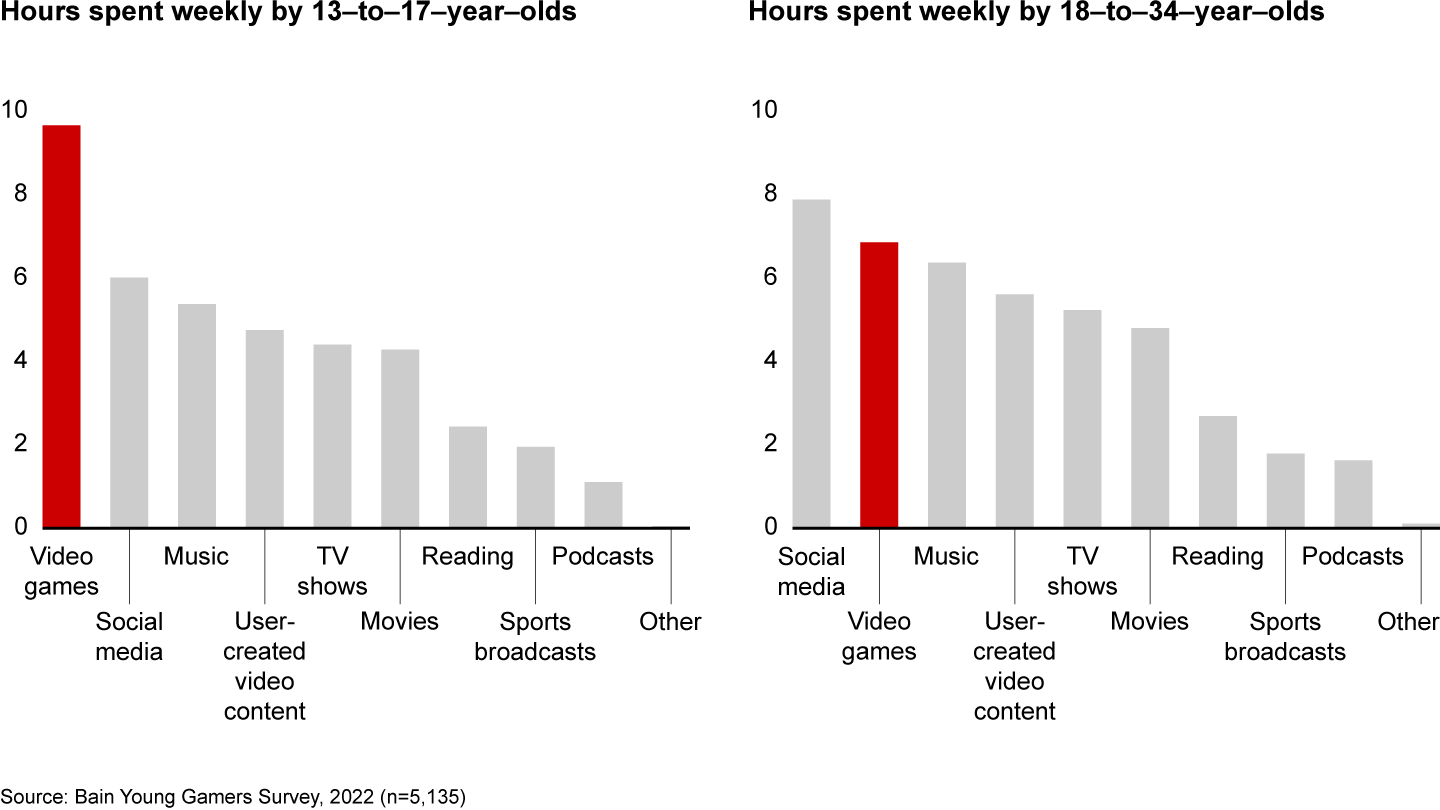
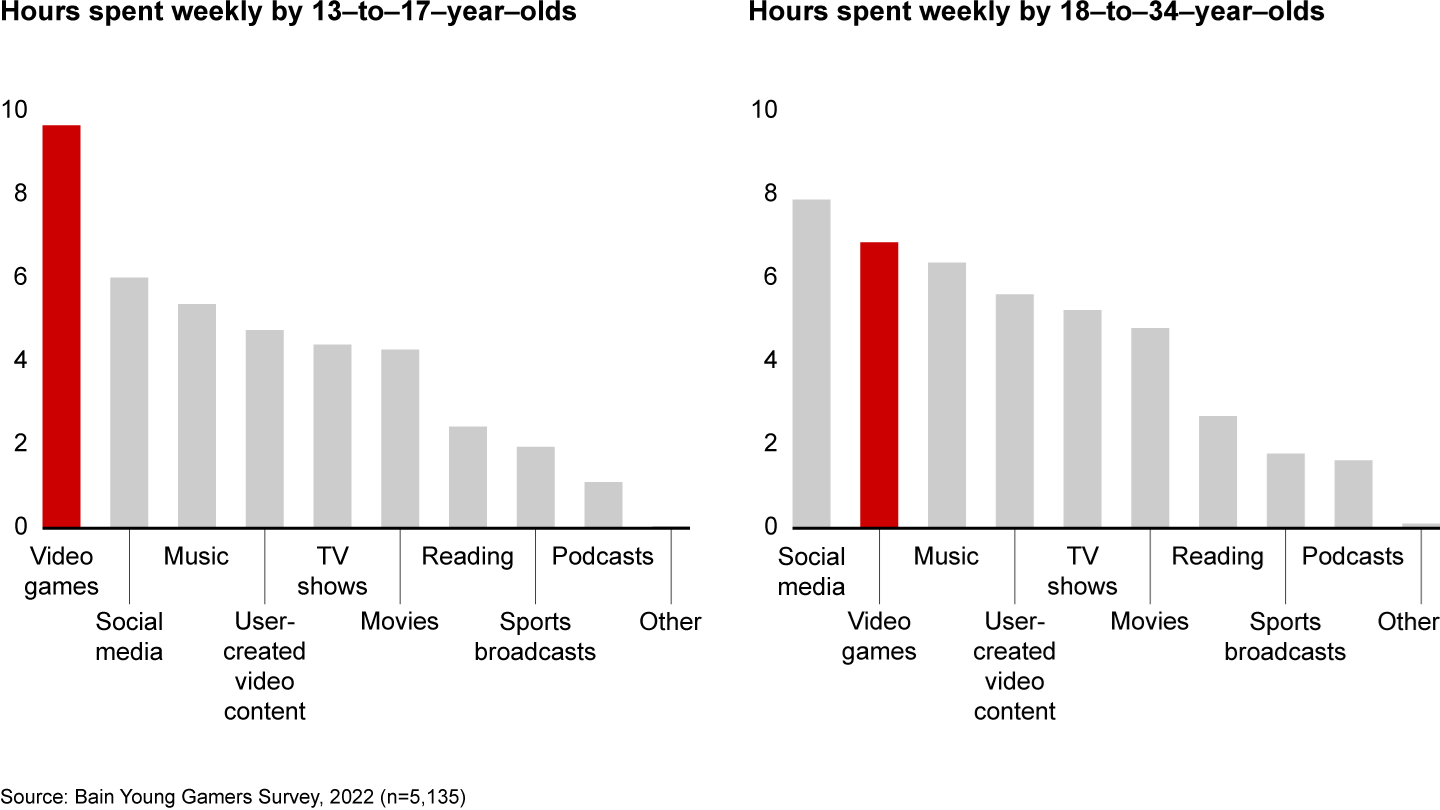
Though gamers have historically trended younger, our data suggests fewer gamers are aging out. This change will likely be supported as gaming becomes the foundation for other media and nonmedia experiences.
Three trends are accelerating these changes in gamers’ consumer behavior.

Young Gamers and the Metaverse: How the Rules of Success Are Changing
Younger gamers spend more time and money on games than older players do, and that has implications for the industry.
Technological advancements. New technology isn’t just making games faster and more visually appealing, it’s changing the nature of games. Increased processing power and reduced latency, due partly to greater 5G connectivity, enable developers to create larger virtual worlds that run on any device. Genshin Impact from miHoYo is one of the most recent games to take advantage of this development.
Virtual and augmented reality are beginning to deliver experiences that live up to the hype and at more competitive prices. One indicator: More Meta Quest 2 headsets have been sold than Xbox Series X and S combined.
Advancements in game engines (principally Unity and Epic Games’ Unreal) are making it easier to develop higher-fidelity games, inviting more developers into the mix. They’re also becoming a key development platform for other entertainment experiences, and improvements in 3-D graphics may transfer to applications in other industries such as healthcare and construction, potentially opening new revenue streams.
As these new development tools make it possible for more developers to provide realistic virtual worlds, they level the playing field. Impressive graphics won’t be the key differentiator. Successful virtual worlds will need to be fun, social, and well designed. The gaming experiences that will revolutionize the industry will do so through innovative game-play and monetization models.
Metaverse-style experiences. Consumers are hungry for more immersive virtual environments, giving technology and media companies an opportunity to hold players’ engagement across various experiences. Live virtual events, e-sports, and socializing are already part of the mix; other media experiences and commerce will follow.

Games Are the Gateway to the Metaverse
Social experiences in game spaces are laying the foundation for other online activities, such as concerts, sporting events, work, and school.
These virtual worlds have certain characteristics that make them well suited to become platforms for new experiences. They’re immersive, but overlap with the physical world. For example, a person may share an identity across different games or across the virtual and real-world environments. They’re persistent; when a user logs off, they continue to exist. They typically allow some level of customization for users, and they often have an e-commerce element that’s important for monetizing that customization.
As noted above, our research finds younger players (13 to 17 years old) very comfortable in virtual worlds, and more likely than older players to believe they’ll spend more time there in the future. Developers should note that cross-play is also important to many of these players, who are 30% more likely to value “interoperability between devices,” compared with older players.
New monetization models. The free-to-play model has been critical to the success of virtual-world games over the last decade by massively expanding the addressable player base and enabling the network effects required for those games to succeed. At 78% of games’ revenue, the free-to-play model itself has advanced with ad-operated becoming more accepted on mobile, and in-app purchases becoming more differentiated. The economics of free-to-play are likely to further explode as virtual-world games become a foundation for the numerous other monetizable experiences (for example, live virtual events, commerce) and more players join the metaverse.
Subscription models are emerging, following other forms of media that have shifted from paid bundles to individual subscription services. Despite heavy marketing and early signs of subscriber satisfaction, this model has received a lukewarm response from the broader gamer community, due to the success of free-to-play and the different way games are consumed compared with other media—fewer titles engaged more deeply.
More games are also using blockchain technology to enable ownership of characters and accessories. But the use of blockchain technology in games is still new and predominantly the reserve of crypto fans. To successfully grow beyond a fringe part of the gaming market, developers will need to focus first on the player experience rather than the marketplace.
In the long run, these different monetization models will increasingly live in harmony. While some premium games will still charge for the initial purchase, free-to-play will be the dominant model, complemented by in-game purchases and subscriptions.
To make the most of these trends and meet the rising expectations of gamers, developers and publishers will want to pay attention to four areas that will differentiate future winners: scale, franchise management, customer experience, and talent.
Scale matters. Large, virtual-world games are expensive to build, in the range of $80 to $300 million and heading toward $1 billion by 2027, based on the historic trajectory. To recoup their development and operational costs, game makers need massive player bases. The free-to-play model has demonstrated success at building scale and generating the necessary network effects that result only from having millions of players and fans to play the game and support the broader franchise.
Game companies can reach scale organically or through partnership with other studios by developing capabilities, finding the right talent, and investing in platform technology. Building a global fan base requires relationships across markets, to ensure access to distribution channels and create essential partnerships.
Scale also depends on scope, connecting with a diverse range of fans and finding multiple ways to monetize the franchise, including in-game purchases, related media, e-sports, and franchise merchandise, both virtual and physical. The biggest companies are broadening their scope by building platforms that aim to provide a home to fans whether they’re playing a game, watching others play, streaming media, socializing, or making purchases. Microsoft’s pursuit of Activision is the most prominent move this year to build scale of consumer base and content.
Beyond the Microsoft―Activision deal, M&A activity is on the rise across the industry (see Figure 3). Historically, the game industry has seen a lot of gaming company-to-gaming company acquisition. Now we’re seeing big tech and media companies entering the arena, which could make the M&A game harder for midsized publishers and studios.
Given the challenges of achieving organic growth and the ferocious M&A activity in the industry, a proactive and strategic M&A approach will be critical to the ambitions of most developer publishers. Some will use acquisitions to fill critical gaps in their own organizations. But many game companies lack a clear and consistent approach and haven’t yet developed the necessary integration capabilities.
To thrive, executives will need to invest in building up their M&A skills, often hiring the expertise they need. Establishing a consistent M&A process, with a clear set of criteria for screening and integrating targets, will be a challenge for most, but essential for long-term survival.
Deal activity in the gaming sector is on the rise, with gaming software and financial investments the fastest-growing segments
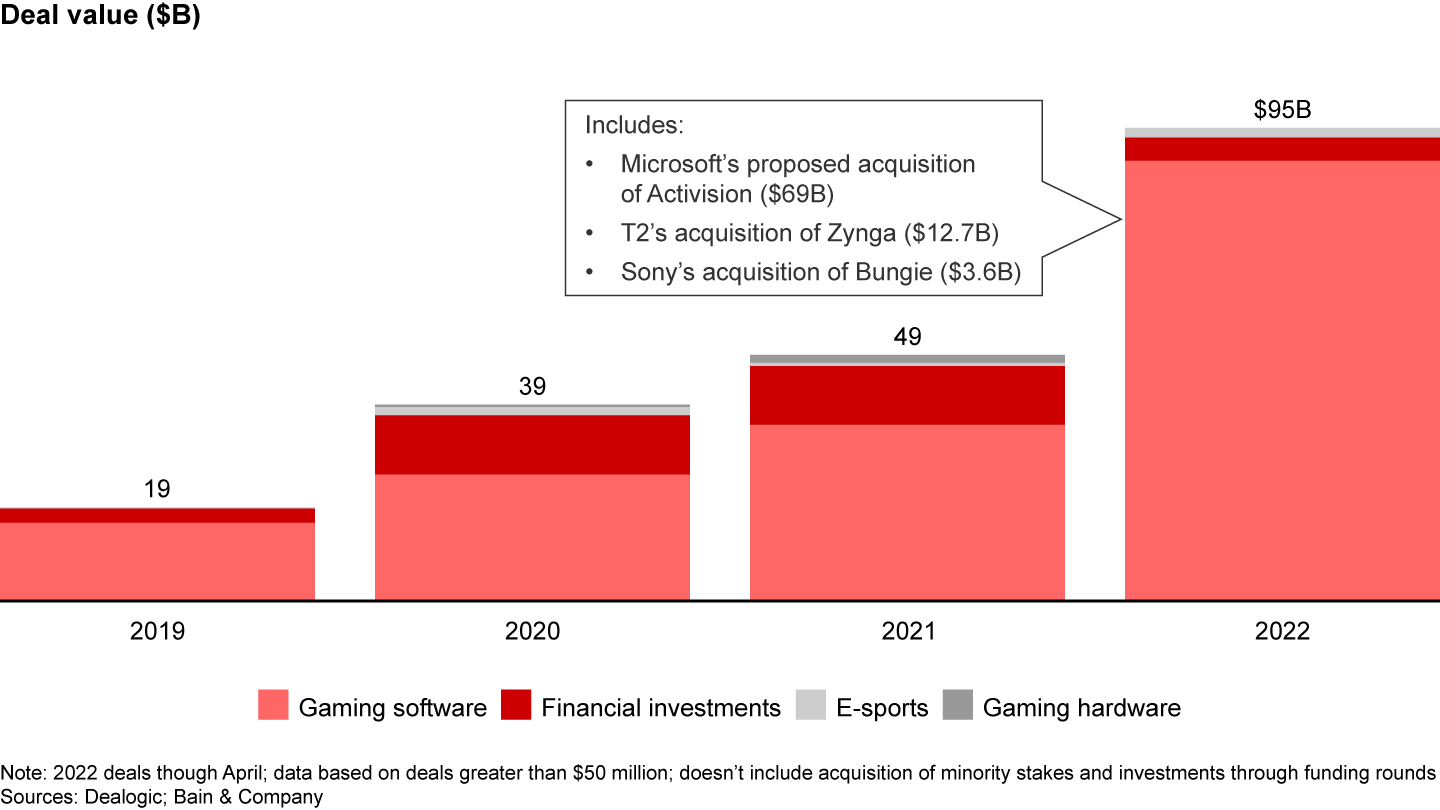
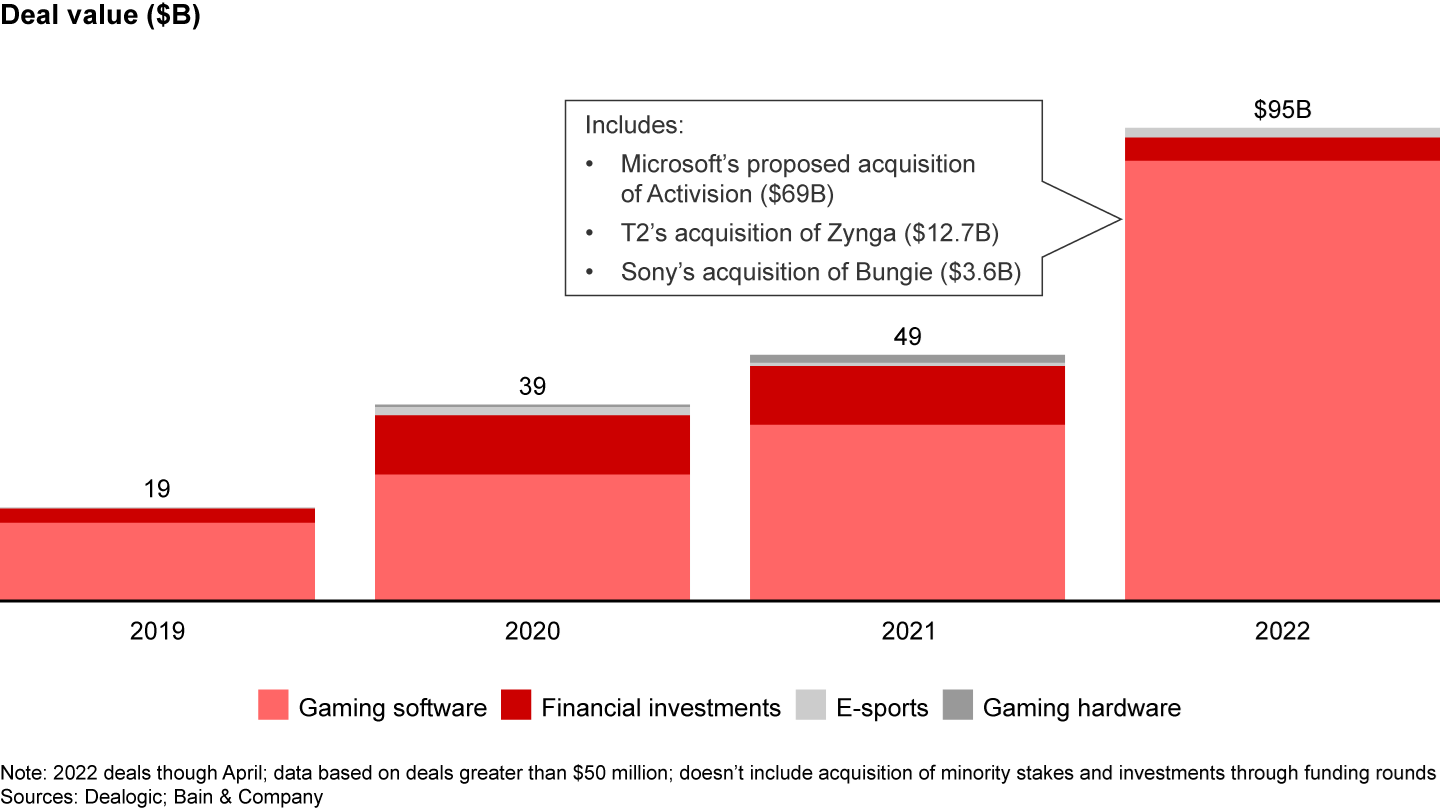
Franchise management increases engagement. As games get bigger, more expensive, and longer lived, it’s more important than ever to develop meaningful and compelling intellectual property (IP), and to manage the franchise over decades. Historically, franchise management has focused on extending a game’s life span through expansions, sequels or, more recently, recurrent content drops in live service games. Big games like League of Legends, Pokémon, and The Witcher have shown the potential of going beyond the game into TV, movies, and other media. The global reach and attractive demographics of the gamer audience make it especially attractive to Hollywood and marketers more broadly.
But most gaming companies need to gain experience in strategically managing a franchise across genres, technologies, and regions. Good franchise management puts the fan at the center of decisions. When deciding what to do next, the most important criterion is “what will engage fans more?” rather than which product is ready to launch or which IP is most developed. Investment decisions will balance how much to spend on the game itself and how much to spend on the franchise beyond it.
New partnerships will be essential, and although deals will share common contours, each one requires its own diligence and management. Investing now in effective franchise-management capabilities can help game companies prepare for the global media deals in their future.
Customer experience takes players beyond the game. As the uses of the metaverse expand and reach scale, video game companies will need to take players on a journey beyond just the game and related media. Customers will expect the ability to move seamlessly between game play, socializing, and commerce, in physical and virtual worlds.
Identity, wallet, and memory of lived experiences will all need to move seamlessly with the consumer across devices and platforms. Every touchpoint has to recognize the consumer and enable a total seamless experience (e.g., one registration, one avatar).
The individual customer journey will also need to be highly personalized. With myriad possible media and nonmedia experiences, companies have to curate a journey that engages consumers based on what they love.
This journey only begins at consumer interactions with the company. With the rise of out-of-game communities like Discord and Reddit, user-created content on TikTok and Twitch, and gaming influencers such as Valkyrae and Asmongold (66% of US teens follow influencers), companies need to establish a proactive approach to building community.
Talent is a top concern. Most video game company executives we speak with cite talent as their No. 1 priority. The supply of top talent isn’t keeping pace with demand, and this imbalance is set to worsen as game companies ramp up to build and maintain large virtual worlds. Bain’s analysis shows video game developers leaving for jobs in big technology firms, which typically pay about 20% more (see Figure 4).
Most developers who leave jobs at tech and video game companies land at big tech companies
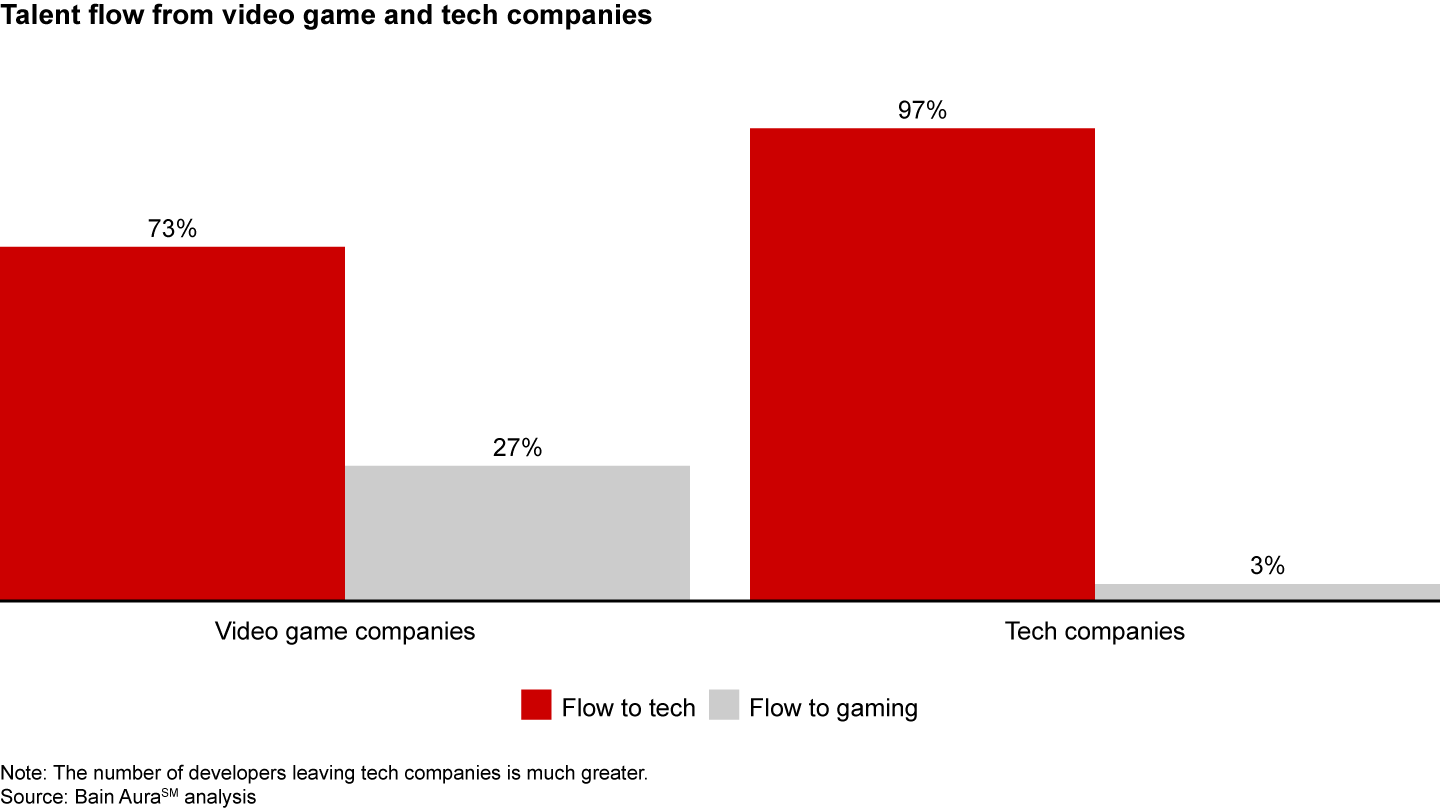
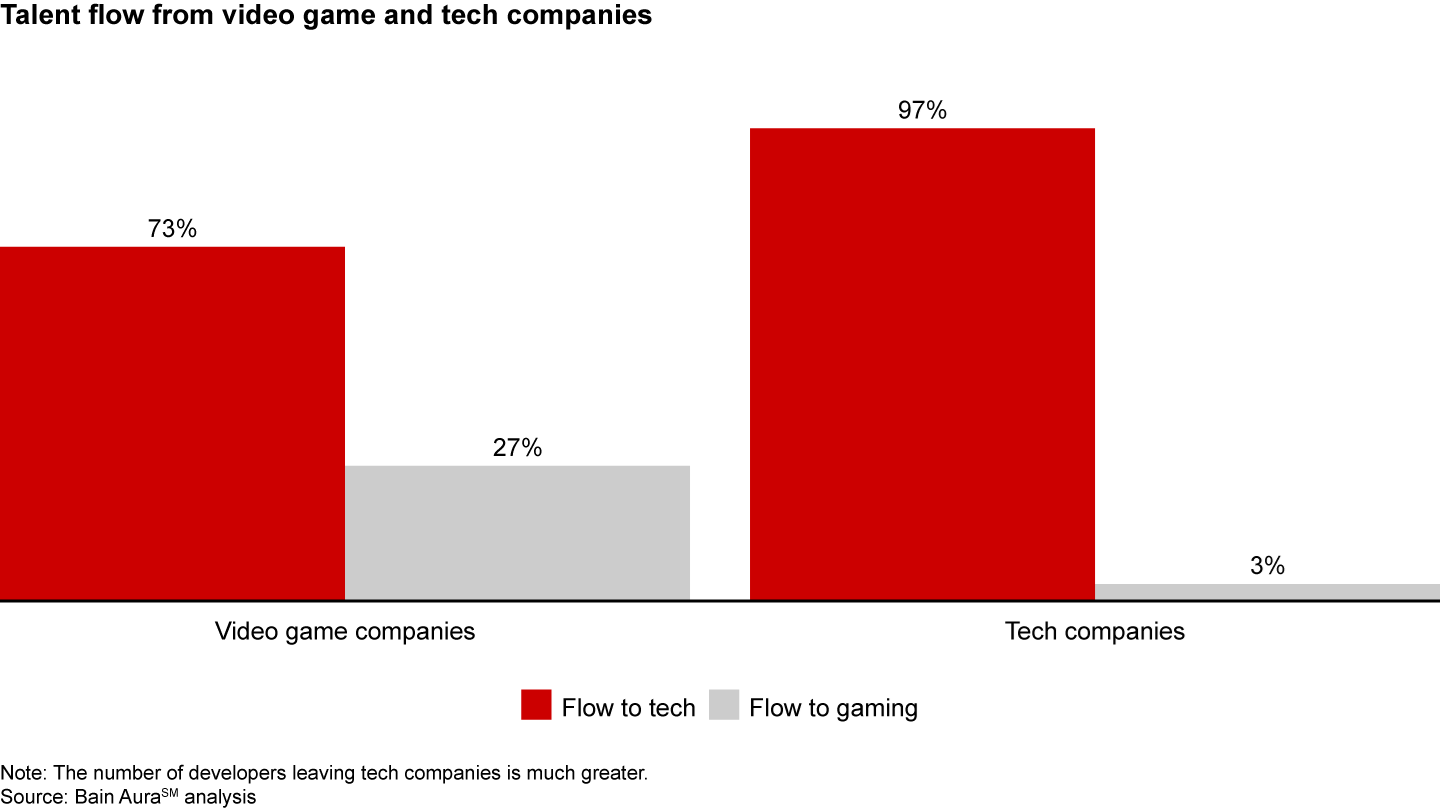
But simply paying more won’t be enough. Better compensation is table stakes; game companies will need to develop a more thoughtful talent strategy around recruitment, onboarding, training, and retention. Too many companies look at human resources simply as an internal function, rather than an indispensable strategic partner to create a forward-looking model that also aligns with the company’s strategy.
Good talent strategy starts with an understanding of strategic advantage—what sets your company apart from competitors? If it’s creativity, then top creative talent should be at the center of your talent model. Remember that these creative leaders have many options (not only with gaming, media, and tech companies, but as the metaverse grows, any brand wanting to be represented), so design a workplace that will keep them engaged and motivated. This means an emphasis on workplace culture, creating an organization that employees advocate for and feel included in.
Getting workplace strategy right is a key element. The hybrid model appears to be here to stay, at least for companies that depend on tech talent. It’s become part of the employee value proposition, and many employees have come to expect and demand it. But many companies are still struggling to find the right balance between remote and office work, while trying to develop consistent norms across locations and functions. For smaller companies, the issue can be easier to resolve, but as companies grow larger and more global, the challenge gets harder.
Finally, one critical aspect of talent strategy is to ensure that the most visionary and ambitious people remain engaged. For some, just working on a large franchise and moving it forward will be enough to satisfy their need for meaningful work. Others may lose interest in a project that endures too long and will focus on the next big thing. Understanding the differences and how to meet these demands will become more important as companies seek to hold onto their most essential employees.
The future of video games is a bright space in the media landscape. But the industry is changing dramatically and more rapidly than in the past. Game developers and publishers will need to develop new skills and sharpen their focus if they want to continue to thrive in an environment that’s becoming more global, more technologically complex, and more deeply integrated with other media platforms and much of the rest of life. Competition is stiffening, particularly for top creative talent. The companies that act quickly to improve their capabilities, talent, partnerships, and market positions will stay above the fray. Are you ready?